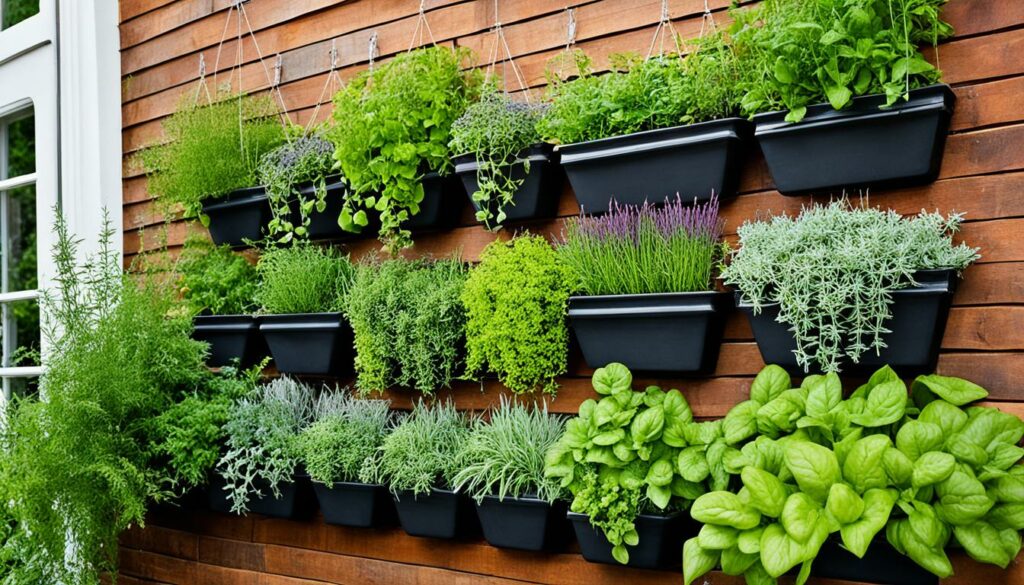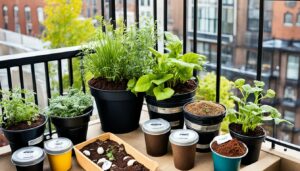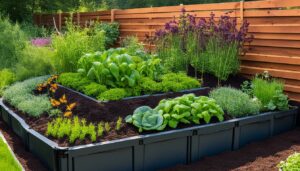Imagine stepping onto your balcony and being greeted by the lush greenery and vibrant aromas of your very own herb haven. In the heart of the city, a balcony herb garden is not only a delightful retreat but a practical solution for small space gardening. Whether you’re an avid home chef or simply enjoy the splendor of nature, growing herbs on a balcony is a fulfilling journey from seed to seasoning.
For urban dwellers, the practice of urban gardening revolutionizes the way we interact with our environment, turning underused spaces into flourishing ecosystems. It’s about crafting a DIY herb garden that fits perfectly with the ebb and flow of apartment living. With a few containers and an assortment of herbs tailored to thrive in herbs for small spaces, even the most compact apartment herb garden can yield a bumper crop of flavorsome foliage.
Seize the opportunity to transform your outdoor area into a verdant, edible landscape. With this guide, you’ll unlock the time-honored secrets that ensure a perky and productive balcony garden. Get ready to cultivate your green thumb and indulge in homegrown herbs right at your fingertips!
Key Takeaways
- Transforming a balcony into a vibrant garden enhances the urban lifestyle.
- Herbs are ideally suited for small spaces, flourishing with minimal room.
- South-facing balconies are prime real estate for sun-loving herbs.
- Proper planter selection and securing methods are essential for windy conditions.
- Knowing your culinary needs helps tailor herb choices for a personalized garden.
- Effective water management is key to prevent oversaturation in containers.
Finding the Best Herbs for Your Balcony Conditions
Container gardening allows you to transform your balcony into a lush culinary oasis, even if you’re in the heart of bustling cities. The best herbs for balcony gardens are not only delightful to the senses but also potentially beneficial to your cooking adventures, particularly if you enjoy Mediterranean cuisine herbs. Balancing sun exposure, space constraints, and personal taste, you can devise a verdant space dotted with culinary herbs like basil, coriander, and thyme.
- If you have a shaded balcony, consider growing mint and parsley, as these forgiving herbs thrive even without direct sunlight.
- Herbs such as rosemary, oregano, and basil love basking in the sun and are apt for balconies graced with ample light.
- Remember to plan for space – fennel, dill, and bay leaves have a sprawly nature and may require larger containers or strategic placement.
Not to be overlooked, the aromatic allure of lavender and sage contributes to a serene atmosphere, while chives and marjoram can easily be tucked into smaller pots, adding swathes of greenery and flavor to your compact garden.
| Herb | Sunlight Needs | Size Requirements |
|---|---|---|
| Oregano | Full sun | Small to medium pots |
| Curry Leaves | Full sun to partial shade | Medium pots |
| Rosemary | Full sun | Large pots for mature plants |
| Thyme | Full sun | Small to medium pots |
| Mint | Partial shade to full sun | Medium pots, preferably contained to limit growth |
In essence, the key to cultivating a thriving balcony garden is to tailor your herb selection to match your environment and culinary tendencies. Include a mix of annuals like coriander and dill, which you can replant each year, alongside perennials such as lavender and sage that offer enduring fragrance and flavor. With the right conditions and a bit of care, your balcony can supply a range of aromatic, fresh culinary herbs for your daily cooking needs.
Choosing the Perfect Containers for Your Herbs
When it comes to balcony gardening tips, selecting the right containers is as important as choosing the herbs themselves. The variety of containers available offers a plethora of opportunities to customize your urban oasis. Whether you’re crafting a year-round herb garden or experimenting with a vertical space, the pot you pick is a vital part of your gardening success.
Understanding Pot Size and Herb Growth
Herbs flourish in pots that cater to their root systems—generally, a container depth for herbs of 6 to 8 inches is sufficient. However, some larger herbs may require more room to spread their roots. Below is a guide to help you understand the optimum pot size for various herbs.
| Herb | Recommended Pot Size | Growth Habit |
|---|---|---|
| Basil | 8-10 inches | Bushy |
| Mint | 12-14 inches | Spreading |
| Rosemary | 10-12 inches | Upright |
| Thyme | 6-8 inches | Mat-forming |
Opting for Drained and Breathable Planter Options
Herbs demand well-drained soil to stay healthy, making drainage a non-negotiable feature for your containers. Choosing pots for herbs with built-in drainage holes or adding them to existing pots is essential. Incorporating materials like grow bags or hanging baskets ensures breathability and prevents root rot.

DIY Planters: Creative Recycling Ideas
Embrace a hands-on approach with DIY pots. Utilize everyday items such as plastic bottles, old boots, or even repurposed furniture to create unique homes for your herbs. Railing planters, window boxes, or vertical gardens not only showcase your creativity but also make efficient use of limited space.
- Reuse tin cans as quaint railing planters for smaller herbs like chives and parsley.
- Larger wooden crates can transform into attractive DIY pots for an array of basil varieties.
- Old guttering fixed to a wall serves as a nifty vertical garden for your culinary herbs.
In tailoring your container choices to your herb garden’s needs, you’ll lay the foundation for a bountiful and beautiful balcony display.
Balcony Herb Garden Maintenance and Care Tips
Creating an oasis of greenery on your balcony is an enchanting way to bring nature closer to home. However, a herb garden care routine is pivotal to ensure the flavors and fragrances of your plants remain vigorous. Let’s delve into the quintessential practices guaranteed to preserve the lushness of your balcony garden.
Firstly, sunlight for herb growth is paramount. Most herbs bask in the glory of the sun, requiring at least six hours of direct light daily. Yet, caring for herbs in the shade shouldn’t be dismissed, as certain herbs prefer a respite from the intense afternoon sun. Positioning your plants to meet their light requirements is essential for their succulence and taste.

Next, balcony gardening care includes a vigilant watering schedule. Fundamentally, it’s about striking a balance to avoid waterlogged soil, which hinders root health. A sage piece of advice is watering in the morning: this encourages deep root development and minimizes evaporation. To further this care, incorporating organic materials such as peat moss helps in retaining optimal moisture levels.
When it comes to fertilization of herbs, less is often more. A diluted solution of balanced liquid fertilizer applied every few weeks serves well. Moreover, for those inclined towards organic gardening, enriching your soil with aged compost or manure will bolster the vitality of your herb garden without the need for synthetic additives.
Regular pruning herbs is also crucial for promoting a bounteous and bushy growth. Utilizing the pinch-back pruning method, which involves removing the top growth and flowers, not only gives shape to your plants but encourages the development of new, flavor-rich leaves – the heart of culinary delight.
- Ensure direct sunlight or partial shade based on herb requirements
- Water in the morning to support deep root growth and minimize water waste
- Add organic matter to potting mix for improved soil fertility
- Prune regularly using the pinch-back method for luxury growth
| Herb | Lighting Needs | Watering Frequency | Fertilization Strategy | Pruning Tips |
|---|---|---|---|---|
| Basil | Full sun | Once soil is dry to the touch | Monthly with diluted liquid fertilizer | Pinch-back to encourage bushiness |
| Mint | Partial shade | Keep consistently moist | Bi-monthly with aged compost | Trim regularly to control invasiveness |
| Rosemary | Full sun to part shade | Allow the top inch of soil to dry between watering | Least demanding, use fertilizer sparingly | Shape as desired, avoid over-pruning |
In conclusion, the vitality of your balcony herb garden is a testament to the care and affection you bestow upon it. With attention paid to sunlight exposure, careful irrigation, and thoughtful pruning, your verdant haven will continue to thrive. Remember, the natural world rewards those who nurture it, and your balcony garden is no different.
Conclusion
As we wrap up our journey into nurturing a green haven on a balcony, we delight in not only the practicality but also the gratification that a well-tended balcony herb garden provides. The whiff of fresh herbs heightens culinary adventures, and the process of harvesting herbs becomes not merely a routine but a moment of connection with nature. Early morning harvests guarantee you the freshest flavors, with herbs reaching their peak when they stand tall at 4-6 inches. This ritual is calming and enriches the soul, signifying the cycle of growth and renewal that urban gardening symbolizes.
Harvesting Your Bounty: Tips for Picking Herbs
Your lush herb garden is your personal trove of flavors waiting to be picked and savored. Gather your herbs snipping wisely to encourage new growth, and relish in the zesty aromas permeating the air. Each snip rewards you with fresh ingredients that can transform your home cooking into gourmet fare. Remember, the practice of harvesting herbs isn’t just about taking; it’s about fostering a continuous cycle of growth. Trim with care, and your garden will be generous in return.
Expanding Beyond Herbs: Integrating Companion Plants
Beyond the realm of savory herbs, ponder the addition of companion plants that can elevate your balcony garden’s diversity and productivity. Embark on growing vegetables on a balcony like cherry tomatoes and sweet peppers, or perhaps try your hand at nurturing balcony fruit trees for a touch of sweetness among the savory. Engage in flower gardening on a balcony to introduce vibrant color and attract beneficial pollinators, or create a serene retreat with a succulent balcony garden. For those yearning for added seclusion, climbing plants offer both beauty and privacy. No matter what choices you make, adding companions is like introducing new characters to a story – they enrich the narrative, bringing layers of interest and interaction to your urban oasis.








